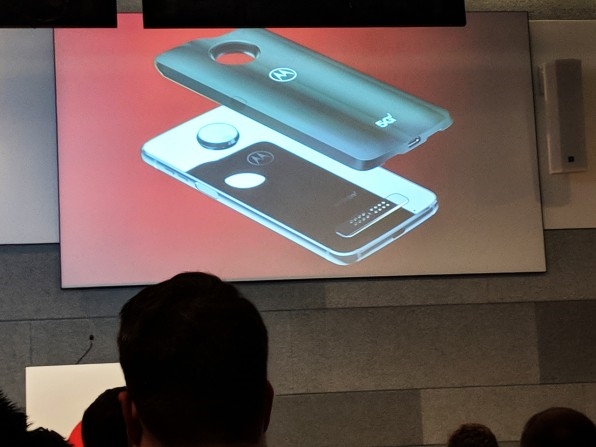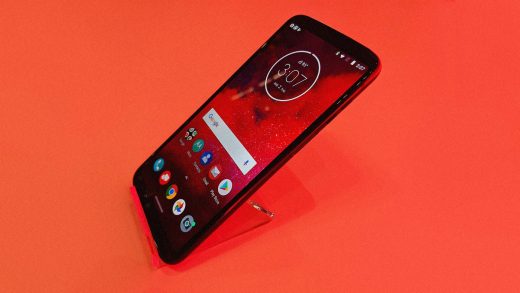Will modular smartphones change the world? We’re about to find out
For the past three years, Motorola has distinguished itself from all the bigger players in the smartphone market with a radical idea: Modular phones that can be altered and upgraded. The company’s Z series phones feature a magnetic back that can attach new peripherals, dubbed “Moto Mods,” to enhance your old phone with high-end cameras, a game controller, a 70-inch screen projector, and of course, battery extenders and speakers. The dream is that consumers will buy one phone that’s future-proof, and thus create less e-waste and spend less money.
Motorola’s worldwide sales are hurting, but it recently doubled its U.S. marketshare (to a modest 5%), while gaining a respectable foothold in Mexico and Brazil thanks largely to the Z. But the larger question remains: Can modularity truly change the way we buy smartphones? We may be about to find out.
At its headquarters in Chicago, Motorola announced its most ambitious Mod yet–a 5G Mod in partnership with Verizon that will be usable on a new phone called the Motorola Z3. The phone itself will hit first shelves on August 16 for $480. Then in early 2019, the new Mod will go on sale at an undisclosed price, allowing you to upgrade the phone to theoretical wireless transmission speeds 10x faster than current 4G phones.
The 5G Mod is a slab of electronics that feels heavy in your hand. Its top lip sticks out over the phone’s bezel, like the flash on an old film camera, to get optimal antenna reception. It’ll still slide into your pocket, though–and promises download speeds of 5 gigabits a second, which would snag you an entire season of Game of Thrones in the time it takes you to board a plane. Even more importantly, the delay between when you send something and when someone receives it is just 1/100th of a second. It makes not just voice, but all complex media from video games to VR, instantaneous in transmission. Of course, no 5G networks exist in the U.S. yet, so Verizon will launch a 5G home router in L.A., Sacramento, and Houston by the end of the year–a toe in the water before upgrading their infrastructure to bring 5G everywhere.
“What you see today will change the way we communicate,” promised Motorola President Sergio Buniac today at the launch event. It may! 5G is an unbelievable technology. But what about Motorola’s vision for the smartphones of the future?

The promise of modular phones like the Z–along with Google’s own, failed Project Ara phone–is that with a small add-on, you can reinvent your device. You can break free of the iPhone upgrade cycle, or whatever cadence you’re on every two years when your contract is up. Why replace parts of your phone that don’t need replacing? You save money. You create less waste. And it all sort of makes sense, right?
But thus far, Motorola’s Mods haven’t really put that theory to the test. It’s not even the company’s fault: There are very few breakthroughs that really make your next smartphone worth buying these days. What is really better in your latest smartphone compared to your last? The screen might be a tiny bit sharper. The processor might be a tiny bit faster. The body might be a tiny bit thinner. We upgrade our phones when they break, or the battery dies its inevitable death, or just because we have an unused credit with our wireless provider contract.
With a 5G upgrade, Motorola would be taking on the biggest bottleneck hold up phone technology, and even computers today: Internet bandwidth. The 5G Mod will even allow you to hardwire tether a PC to it, or connect up to 10 devices wirelessly. It’s obvious that Verizon sees 5G as a play, not just for the mobile subscription market, but home internet, too.
The problem with breakthroughs, though, is that they break things. The Z3 will support 5G when it launches immediately. Existing Z2 users will get support sometime later in 2019. But what about the first Z buyers, who invested in the idea of a modular phone in 2016? Motorola isn’t promising that it will get the 5G upgrade just yet. The original Z, like any phone from 2016, wasn’t necessarily engineered to support 5G. So Motorola currently says it might support this amazing add-on–and it might not! When I press executives as to why, they say there isn’t necessarily a technical limitation limiting the original phones–but also won’t promise that there isn’t a technical limitation, either. “It’s certainly our intent to do so,” says Doug Michau, head of product operations at Motorola Mobility. “If there was a technical challenge, we’d have to assess at the time, but to be very transparent…I don’t think there would be a block. It’s just hard to commit before we get started.”
No designer or engineer can read the tea leaves so well that they can imagine exactly what today’s phones might need to support tomorrow’s technology. It’s an inevitable fact that Motorola and other modular proponents may eventually run up against an insurmountable wall of progress–if not today with 5G and original Z phone, then in three years with some new technology we haven’t even heard of yet. Yes, the Motorola Z platform allows you to swap in a single, modular upgrade. But modularity can’t protect core parts of the Z’s guts from obsolescence. That would require swappable processors, RAM, GPUs, and all the things we find in new smartphones. And at that point, does modularity still make sense? Aren’t you just sticking a new phone onto your old phone?
Perhaps truly future-proofing consumer technology like smartphones will always remain out of reach. Maybe the Z platform isn’t a forever phone–just a three, four, or five-year phone. But if Motorola does get 5G speeds working on a phone from 2016 (when 2017’s iPhone X only runs 4G)? That is a coup in its own way.
(48)



